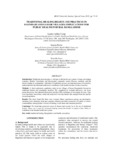Traditional healing beliefs and practices in Bagnibari and Samair villages: implications for public health in rural Bangladesh
Citation
Camp, L. A., Pervin, J., & Raza, F. (2012). Traditional healing beliefs and practices in Bagnibari and Samair villages: implications for public health in rural Bangladesh, BRAC University Journal, Special Issue, 71–87.Abstract
Introduction: Traditional medicine plays a vital part in the health care systems of many developing countries. Healers’ knowledge and background, commonly treated illnesses, methods, and the factors leading to communities’ utilization of traditional services are important areas of research to understand how the informal health sector contributes to the health outcomes in these countries.
Methods: A short exploratory, qualitative study in two villages of Savar, Bangladesh focused on traditional healers and community members. We completed six in-depth interviews, one focus group discussion, four informal discussions and three PRA techniques to investigate the issue. Data were translated, transcribed, coded and analyzed to develop themes that emerged from the specific research questions.
Results: The study found that there were common illness experiences among our participants, including fever, headache, body pain, jaundice, diarrhea and illness caused by evil spirits, as well as commonalities among healers in terms of training, social status and treatment practices.
Conclusion: We found that perceived causes of disease and severity led to the use of traditional healers. There was a need for increased training among the healers to improve their ability to contribute to the broader health care system.

